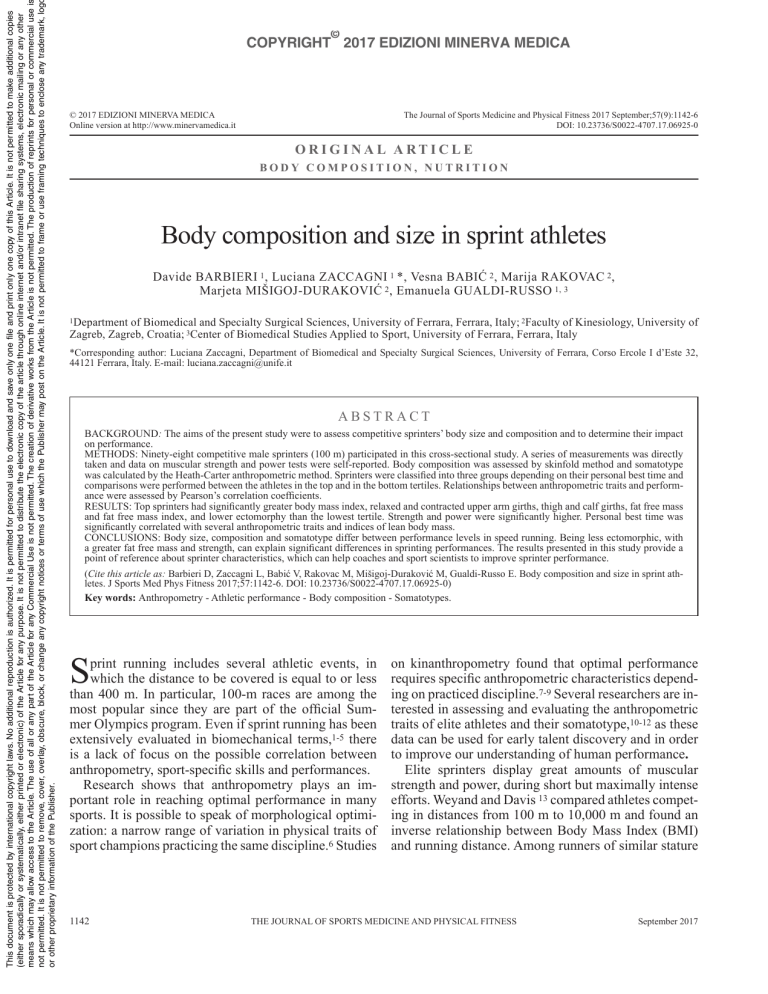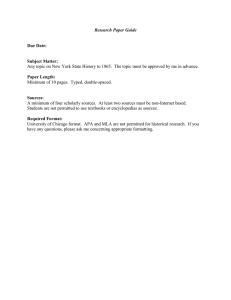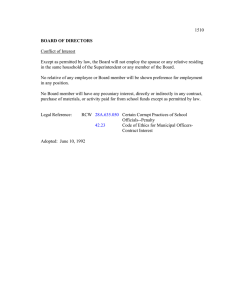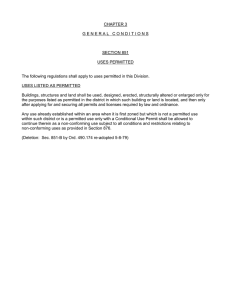
This document is protected by international copyright laws. No additional reproduction is authorized. It is permitted for personal use to download and save only one file and print only one copy of this Article. It is not permitted to make additional copies (either sporadically or systematically, either printed or electronic) of the Article for any purpose. It is not permitted to distribute the electronic copy of the article through online internet and/or intranet file sharing systems, electronic mailing or any other means which may allow access to the Article. The use of all or any part of the Article for any Commercial Use is not permitted. The creation of derivative works from the Article is not permitted. The production of reprints for personal or commercial use i not permitted. It is not permitted to remove, cover, overlay, obscure, block, or change any copyright notices or terms of use which the Publisher may post on the Article. It is not permitted to frame or use framing techniques to enclose any trademark, log or other proprietary information of the Publisher. © COPYRIGHT 2017 EDIZIONI MINERVA MEDICA © 2017 EDIZIONI MINERVA MEDICA Online version at http://www.minervamedica.it The Journal of Sports Medicine and Physical Fitness 2017 September;57(9):1142-6 DOI: 10.23736/S0022-4707.17.06925-0 ORIGINAL ARTICLE BODY COMPOSITION, NUTRITION Body composition and size in sprint athletes Davide BARBIERI 1, Luciana ZACCAGNI 1 *, Vesna BABIĆ 2, Marija RAKOVAC 2, Marjeta MIŠIGOJ‑DURAKOVIĆ 2, Emanuela GUALDI‑RUSSO 1, 3 1Department of Biomedical and Specialty Surgical Sciences, University of Ferrara, Ferrara, Italy; 2Faculty of Kinesiology, University of Zagreb, Zagreb, Croatia; 3Center of Biomedical Studies Applied to Sport, University of Ferrara, Ferrara, Italy *Corresponding author: Luciana Zaccagni, Department of Biomedical and Specialty Surgical Sciences, University of Ferrara, Corso Ercole I d’Este 32, 44121 Ferrara, Italy. E-mail: luciana.zaccagni@unife.it A B S T RAC T BACKGROUND: The aims of the present study were to assess competitive sprinters’ body size and composition and to determine their impact on performance. METHODS: Ninety-eight competitive male sprinters (100 m) participated in this cross-sectional study. A series of measurements was directly taken and data on muscular strength and power tests were self-reported. Body composition was assessed by skinfold method and somatotype was calculated by the Heath-Carter anthropometric method. Sprinters were classified into three groups depending on their personal best time and comparisons were performed between the athletes in the top and in the bottom tertiles. Relationships between anthropometric traits and performance were assessed by Pearson’s correlation coefficients. RESULTS: Top sprinters had significantly greater body mass index, relaxed and contracted upper arm girths, thigh and calf girths, fat free mass and fat free mass index, and lower ectomorphy than the lowest tertile. Strength and power were significantly higher. Personal best time was significantly correlated with several anthropometric traits and indices of lean body mass. CONCLUSIONS: Body size, composition and somatotype differ between performance levels in speed running. Being less ectomorphic, with a greater fat free mass and strength, can explain significant differences in sprinting performances. The results presented in this study provide a point of reference about sprinter characteristics, which can help coaches and sport scientists to improve sprinter performance. (Cite this article as: Barbieri D, Zaccagni L, Babić V, Rakovac M, Mišigoj-Duraković M, Gualdi-Russo E. Body composition and size in sprint athletes. J Sports Med Phys Fitness 2017;57:1142-6. DOI: 10.23736/S0022-4707.17.06925-0) Key words: Anthropometry - Athletic performance - Body composition - Somatotypes. S print running includes several athletic events, in which the distance to be covered is equal to or less than 400 m. In particular, 100-m races are among the most popular since they are part of the official Summer Olympics program. Even if sprint running has been extensively evaluated in biomechanical terms,1-5 there is a lack of focus on the possible correlation between anthropometry, sport-specific skills and performances. Research shows that anthropometry plays an important role in reaching optimal performance in many sports. It is possible to speak of morphological optimization: a narrow range of variation in physical traits of sport champions practicing the same discipline.6 Studies 1142 on kinanthropometry found that optimal performance requires specific anthropometric characteristics depending on practiced discipline.7-9 Several researchers are interested in assessing and evaluating the anthropometric traits of elite athletes and their somatotype,10-12 as these data can be used for early talent discovery and in order to improve our understanding of human performance. Elite sprinters display great amounts of muscular strength and power, during short but maximally intense efforts. Weyand and Davis 13 compared athletes competing in distances from 100 m to 10,000 m and found an inverse relationship between Body Mass Index (BMI) and running distance. Among runners of similar stature The Journal of Sports Medicine and Physical Fitness September 2017 This document is protected by international copyright laws. No additional reproduction is authorized. It is permitted for personal use to download and save only one file and print only one copy of this Article. It is not permitted to make additional copies (either sporadically or systematically, either printed or electronic) of the Article for any purpose. It is not permitted to distribute the electronic copy of the article through online internet and/or intranet file sharing systems, electronic mailing or any other means which may allow access to the Article. The use of all or any part of the Article for any Commercial Use is not permitted. The creation of derivative works from the Article is not permitted. The production of reprints for personal or commercial use i not permitted. It is not permitted to remove, cover, overlay, obscure, block, or change any copyright notices or terms of use which the Publisher may post on the Article. It is not permitted to frame or use framing techniques to enclose any trademark, log or other proprietary information of the Publisher. © COPYRIGHT 2017 EDIZIONI MINERVA MEDICA BODY COMPOSITION AND SIZE IN SPRINT ATHLETES and body fat percentage, having a relatively large body mass appears to improve sprinting performances, suggesting that running has a structural basis.14 The aims of the present study were to assess anthropometrically a sample of competitive male sprinters, and to elucidate the potential correlations between anthropometric traits, muscular strength and performance. Materials and methods The present cross-sectional study involved 98 male competitive sprinters with different levels of qualification (competing at least at national level), predominantly Caucasians (92% of the sample; the remainders have African origins), aged 23.1±6.3 years. The athletes volunteered for the research and gave their written informed consent. The protocol was approved by the Ethical Committees of the University of Ferrara (Italy; registration no. 83-2012) and of the University of Zagreb (Croatia; recorded on April 22nd, 2013). Test procedures Measurements and personal data were collected on the field in 2012-2013. Athletes were assessed during national-level meetings at the Communal Athletics Court in Modena (Italy), or at the Faculty of Kinesiology of the University of Zagreb (Croatia). The following measures were taken: weight (kg), stature (cm), humerus and femur breadths (cm), mid-thigh, calf, relaxed and contracted upper arm girths (cm), skinfold thicknesses (mm) at triceps, thorax, sub-scapula, supra-iliac and calf sites. All measurements were taken by trained anthropometrists according to the International Biological Program (IBP) standardized anthropometric procedures, on the left side of the body.15 A portable stadiometer (free-standing Magnimeter, Raven Equipment Ltd., Dunmow, UK) was used to measure stature to the nearest 0.1 cm; weight was measured to the nearest 0.1 kg with a high precision mechanical scale; breadths were taken to the nearest 0.1 cm with a large sliding caliper; girths were taken to the nearest 0.1 cm with a tape measure; skinfold thicknesses were taken to the nearest 1 mm with a Lange caliper (Beta Technology Inc., Houston, TX, USA). Body density (BD, g/mL) was calculated using the equation by Jackson and Pollock 16 with three skinfolds Vol. 57 - No. 9 BARBIERI (triceps, thorax and sub-scapula). Body fat percentage (%BF) was calculated from BD using Siri’s equation.17 Fat mass (FM, kg) was calculated as (%BF·Weight)/100 and fat-free mass (FFM, kg) as Weight – FM. The following anthropometric indices were calculated: BMI (BMI = weight/stature2, kg/m2) as a measure of weight status with overweight defined as BMI≥25 kg/m2; Fat Mass Index (FMI = FM/stature2, kg/m2), and Fat-Free Mass Index (FFMI = FFM/stature2, kg/m2). Somatotype components (endomorphy, mesomorphy, ectomorphy) were calculated by means of the HeathCarter anthropometric method.18 Results in the most common exercises used in sprinting to train and test muscular strength and power were self-reported by the subjects: 1 repetition maximum (1RM, i.e. the highest weight which can be lifted in a single repetition of the given exercise) in the squat, clean, and snatch, and best performance achieved in the standing long jump test. In case 1RM was not available, it was estimated by means of the relationship between number of repetitions and percentage of 1RM, according to Beachle and Earle.19 Also, force relative to body weight (Frel = 1RM/weight) in the three weight-lifting exercises was calculated. Official national databases provided information on personal best (PB) time of the examined athletes on the 100-m distance. Statistical analysis Distribution normality of each variable was checked. Athletes were classified into three groups according to their PB. Comparisons between athletes in the top (the fastest) and bottom (the slowest) tertiles were performed by means of the t-test. To examine whether body composition parameters or body size were associated with performance, Pearson’s correlation analysis was performed. Significance was set at P<0.05. Statistica v. 11.0 (StatSoft Italia srl, Padua, Italy) software package was used to perform all the statistical analyses. Results The mean PB time in the 100 m of athletes examined in this study was 11.33±0.53 s. Table I presents the mean values of anthropometric traits, body composition parameters, somatotype and strength values of the examined sprinters. The mean %BF value corresponded to The Journal of Sports Medicine and Physical Fitness 1143 This document is protected by international copyright laws. No additional reproduction is authorized. It is permitted for personal use to download and save only one file and print only one copy of this Article. It is not permitted to make additional copies (either sporadically or systematically, either printed or electronic) of the Article for any purpose. It is not permitted to distribute the electronic copy of the article through online internet and/or intranet file sharing systems, electronic mailing or any other means which may allow access to the Article. The use of all or any part of the Article for any Commercial Use is not permitted. The creation of derivative works from the Article is not permitted. The production of reprints for personal or commercial use i not permitted. It is not permitted to remove, cover, overlay, obscure, block, or change any copyright notices or terms of use which the Publisher may post on the Article. It is not permitted to frame or use framing techniques to enclose any trademark, log or other proprietary information of the Publisher. © COPYRIGHT 2017 EDIZIONI MINERVA MEDICA BARBIERI BODY COMPOSITION AND SIZE IN SPRINT ATHLETES Table I.—Anthropometric characteristics of 100-m sprinters (N.=98) and correlations with personal best time in 100 m. Traits Measured traits Weight (kg) Stature (cm) Body Mass Index (kg/m2) Relaxed upper arm girth (cm) Contracted upper arm girth (cm) Thigh girth (cm) Calf girth (cm) Body density (g/mL) % body fat Fat mass (kg) Fat Mass Index (kg/m2) Fat-free mass (kg) Fat-Free Mass Index (kg/m2) Endomorphy Mesomorphy Ectomorphy Self-reported traits Squat (kg) Clean (kg) Snatch (kg) Standing long jump (cm) Relative force (squat) Relative force (clean) Relative force (snatch) Mean±SD Pearson’s r P value Traits 73.0±7.5 177.9±7.1 23.0±1.8 29.6±2.2 32.5±2.5 54.3±3.0 38.2±2.2 1.082±0.007 7.7±2.9 5.6±2.4 1.8±0.8 67.4±7.0 21.3±1.5 2.1±0.7 5.0±1.2 2.6±0.9 -0.2713 -0.0095 -0.3605 -0.4549 -0.5211 -0.2513 -0.2325 -0.0219 0.0212 -0.0427 -0.0447 -0.2735 -0.3976 0.0250 -0.2390 0.2984 0.0085 0.9280 0.0004 0.0001 0.0001 0.0151 0.0249 0.8346 0.8399 0.6842 0.6707 0.0079 0.0001 0.8117 0.0210 0.0037 123.7±31.0 84.4±21.7 66.6±13.1 293.3±22.5 1.69±0.38 1.14±0.27 0.88±0.16 -0.5843 -0.4537 -0.3641 -0.5101 -0.5185 -0.4108 -0.3496 0.0001 0.0004 0.0086 0.0001 0.0001 0.0018 0.0119 Measured traits Weight (kg) Stature (cm) Body Mass Index (kg/m2) Relaxed upper arm girth (cm) Contracted upper arm girth (cm) Thigh girth (cm) Calf girth (cm) Body density (g/mL) % body fat Fat mass (kg) Fat Mass Index (kg/m2) Fat-free mass (kg) Fat-Free Mass Index (kg/m2) Endomorphy Mesomorphy Ectomorphy Self-reported traits Squat (kg) Clean (kg) Snatch (kg) Standing long jump (cm) Relative force (squat) Relative force (clean) Relative force (snatch) ultra-lean and no athlete was overfat. Mean BMI value was in the normal weight status. Nonetheless, 15 athletes were classified as overweight, while the rest were all in the normal weight category. Mean FMI value was lower than the 5th percentile and mean FFMI value was higher than the 95th percentile according to Schuts et al.20 Mean overall somatotype (2.1-5.0-2.6) fell into the ectomorphic mesomorph category. For what concerns relative strength values, results show that strength-to-body weight ratio, as measured by means of the squat, was almost double, while it was close to one if measured by means of the snatch. Moreover, Table I shows correlations between sprint time and anthropometric traits. Weight, BMI, all girths, FFM, FFMI and mesomorphy were negatively correlated to 100-m PB; while ectomorphy was positively correlated. All strength traits (both absolute and relative) were significantly and negatively correlated to PB, implying, therefore, a positive correlation with performance. Means and standard deviations for anthropometric and strength traits by level of performance were 1144 Table II.—Anthropometric characteristics (mean±SD) and t-test P values: sprinters in 1st tertile versus sprinters in 3rd tertile. 1st tertile (fastest) 3rd tertile (slowest) P value 76.4±6.7 178.1±6.1 24.1±1.8 31.1±2.0 34.5±2.0 55.7±3.0 39.2±2.4 1.081±0.008 7.9±3.5 6.1±3.1 1.9±1.0 70.3±6.0 22.2±1.5 2.0±0.9 5.4±1.1 2.2±0.9 71.9±7.1 177.6±7.9 22.8±1.6 28.9±1.8 31.7±1.9 53.7±3.2 37.9±2.1 1.082±0.007 7.7±2.9 5.6±2.3 1.8±0.7 66.3±6.6 21.0±1.3 2.0±0.6 4.8±1.4 2.7±0.9 0.0127 0.8052 0.0034 0.0001 0.0001 0.0170 0.0318 0.8263 0.8194 0.4511 0.4801 0.0149 0.0019 0.8310 0.0742 0.0228 146.6±26.9 94.2±18.1 71.5±11.7 306.6±18.6 1.94±0.36 1.25±0.22 0.86±0.28 110.6±23.3 72.9±18.7 63.0±12.3 282.7±22.1 1.27±0.65 0.76±0.48 0.57±0.42 0.0001 0.0013 0.0562 0.0003 0.0001 0.0001 0.0088 summarized in Table II. Comparisons (t-test) between sprinters in 1st and 3rd tertile in the 100-m race show several significant differences: weight, BMI, all girths, FFM, FFMI, ectomorphy and strength values were significantly different, with the exception of the snatch, which approached significance. The fastest sprinters had one and a half higher performance in relative strength data than the slowest ones. The best sprint times were attained by athletes proportionally heavier (greater BMI), with greater limbs girths, higher FFM and FFMI, lower ectomorphy and greater muscular strength and power. Discussion Anthropometric approaches have proved very effective in the assessment of exercise performance. In the present study, the anthropometric characteristics of a large sample of competitive sprinters were analyzed to investigate whether body composition parameters, somatotype and anthropometric characteristics were related to performances in the 100-m race using compari- The Journal of Sports Medicine and Physical Fitness September 2017 This document is protected by international copyright laws. No additional reproduction is authorized. It is permitted for personal use to download and save only one file and print only one copy of this Article. It is not permitted to make additional copies (either sporadically or systematically, either printed or electronic) of the Article for any purpose. It is not permitted to distribute the electronic copy of the article through online internet and/or intranet file sharing systems, electronic mailing or any other means which may allow access to the Article. The use of all or any part of the Article for any Commercial Use is not permitted. The creation of derivative works from the Article is not permitted. The production of reprints for personal or commercial use i not permitted. It is not permitted to remove, cover, overlay, obscure, block, or change any copyright notices or terms of use which the Publisher may post on the Article. It is not permitted to frame or use framing techniques to enclose any trademark, log or other proprietary information of the Publisher. © COPYRIGHT 2017 EDIZIONI MINERVA MEDICA BODY COMPOSITION AND SIZE IN SPRINT ATHLETES sons between extreme groups (first and third tertiles) and correlation analysis on the total sample. Relative to standard cut-off values, our sprinters had a low %BF. Still, their BMI was in the upper normalweight range, which accounts for a lean body with a large muscle mass. Our results confirm the lack of sensitivity of BMI as an index of adiposity in athletes,21 reflecting the amount of lean body mass in sprinters, as in other power-oriented sports.22 In athletes with a low %F like sprinters, a high BMI can be considered an index of large muscle mass and, consequently, an index of absolute and relative strength. The somatotype components were significantly correlated with PB in 100-m sprinters. In particular, our findings support the hypothesis that mesomorphy is positively associated and ectomorphy, and more in general slenderness, negatively correlated with acceleration and therefore shorter sprints up to 100 m. Comparative data from literature related to sprinters’ somatotype are limited, but a confirmation of the findings discussed above on runners comes from a comparison with previous studies.1, 23, 24 According to Figure 1, the endomorphic component was little developed in all runners, as expected. Ectomorphy increased and mesomorphy decreased as race distance increased. Among the examined sprinters strong correlations resulted between both absolute and relative strength and performance. This is an important association, as increases in lower-body strength, measured by means of the squat, transfer positively to sprint performance, Sprinters (present study) Sprinters 1 Sprinters 24 400 m 24 Middle-distance 24 Long-distance 24 Marathon 23 BARBIERI according to the level of practice and body mass of the athlete.25 The present study found a correlation between standing long jump and performance in 100 m. This interesting association has been poorly researched to date. Limitations of the study While the athletes’ anthropometric data were collected by trained anthropometrists using standardized methods, strength-related data were recorded on the basis of the athletes’ personal declarations. This fact can be the main limitation of our research. Outside of an official competition, it can be difficult to assess the real 1RM of an exercise. In the squat, for example, the depth of the lift can change significantly the outcome of the test. This should not be the case with the Olympic lifts, where weights are lifted from the ground to lockout position. Still, not all sprinters perform these lifts or focus on them equally. Also, in case the 1RM was estimated, the real value may slightly differ from the tested one. Further, although the sample size was large, the sprinters participating in the current research were only males. It has yet to be determined if the observed associations between anthropometric traits and performance are similar for female sprinters. Conclusions In summary, our study found that PB times achieved by 100 m sprinters varied according to body size and somatotype. Sprinters with larger muscle mass and lower adiposity, less ectomorphy and more strength had better performances. Coaches and sport scientists can use data about sprinter characteristics as reference elements helping them to realize their personal potential. Further studies are needed to fully understand performance predictors and to develop new anthropometric models for the athletes in sprint running. References Figure 1.—Distribution of mean somatotypes in runners on the somatochart. Vol. 57 - No. 9 1.Aerenhouts D, Delecluse C, Hagman F, Taeymans J, Debaere S, Van Gheluwe B, et al. Comparison of anthropometric characteristics and sprint start performance between elite adolescent and adult sprint athletes. Eur J Sport Sci 2012;12:9-15. 2. Bret C, Rahmani A, Dufour AB, Messonnier L, Lacour JR. Leg strength and stiffness as ability factors in 100 m sprint running. J Sports Med Phys Fitness 2002;42:274-81. The Journal of Sports Medicine and Physical Fitness 1145 This document is protected by international copyright laws. No additional reproduction is authorized. It is permitted for personal use to download and save only one file and print only one copy of this Article. It is not permitted to make additional copies (either sporadically or systematically, either printed or electronic) of the Article for any purpose. It is not permitted to distribute the electronic copy of the article through online internet and/or intranet file sharing systems, electronic mailing or any other means which may allow access to the Article. The use of all or any part of the Article for any Commercial Use is not permitted. The creation of derivative works from the Article is not permitted. The production of reprints for personal or commercial use i not permitted. It is not permitted to remove, cover, overlay, obscure, block, or change any copyright notices or terms of use which the Publisher may post on the Article. It is not permitted to frame or use framing techniques to enclose any trademark, log or other proprietary information of the Publisher. © COPYRIGHT 2017 EDIZIONI MINERVA MEDICA BARBIERI BODY COMPOSITION AND SIZE IN SPRINT ATHLETES 3.Devita P, Fellin RE, Seay JF, Ip E, Stavro N, Messier SP. The relationships between age and running biomechanics. Med Sci Sports Exerc 2016;4:98-106. 4.Hunter JP, Marshall RN, McNair PJ. Interaction of step length and step rate during sprint running. Med Sci Sports Exerc 2004;36:26171. 5. Slawinski J, Bonnefoy A, Ontanon G, Leveque JM, Miller C, Riquet A, et al. Segment-interaction in sprint start: Analysis of 3D angular velocity and kinetic energy in elite sprinters. J Biomech 2010;43:1494-502. 6.O’Connor H, Olds T, Maughan RJ, International Association of Athletics Federations. Physique and performance for track and field events. J Sports Sci 2007;25:S49-60. 7.Norton K, Olds T, Olive S, Craig N. Anthropometry and Sports Performance. In: Norton K, Olds T, editors. Anthropometrica. Sidney: University of New South Wales Press Ltd.; 2004. p. 289-365. 8. Zaccagni L. Anthropometric characteristics and body composition of Italian national wrestlers. Eur J Sport Sci 2012;12:145-51. 9. Zaccagni L, Onisto N, Gualdi-Russo E. Biological characteristics and ageing in former elite volleyball players. J Sci Med Sport 2009;12:667-72. 10. Barbieri D, Zaccagni L, Cogo A, Gualdi-Russo E. Body composition and somatotype of experienced mountain climbers. High Alt Med Biol 2012;13:46-50. 11. Kandel M, Baeyens JP, Clarys P. Somatotype, training and performance in Ironman athletes. Eur J Sport Sci 2014;14:301-8. 12. Watts AS, Coleman I, Nevill A. The changing shape characteristics associated with success in world-class sprinters. J Sports Sci 2012;30:1085-95. 13. Weyand PG, Davis JA. Running performance has a structural basis. J Exp Biol 2005;208:2625-31. 14. Weyand PG, Sternlight DB, Bellizzi MJ, Wright S. Faster top running speeds are achieved with greater ground forces not more rapid leg movements. J Appl Physiol 2000;89:1991-9. 15. Weiner JS, Lourie JA. Practical Human Biology. London: Academic Press; 1981. 16. Jackson AS, Pollock ML. Practical Assessment of Body Composition. The Physician and Sports Medicine 1985;13:76-90. 17. Siri WE. Body composition from fluid spaces and density: Analysis of methods. In: Brozek J, Henzchel A, editors. Techniques for Measuring Body Composition. Washington: National Academy of Sciences; 1961. p. 224-44. 18.Carter JEL. The Heath-Carter Anthropometric Somatotype- Instruction Manual. Dep. of Exercise and Nutritional Science, San Diego State University (CA, USA); 2002 [Internet]. Available from: www.somatotype.org/Heath-CarterManual.pdf [cited 2017, Mar 21]. 19. Beachle TR, Earle RV. Essentials of Strength Training and Conditioning. 3rd Ed. Champaign: Human kinetics; 2008. 20. Schutz Y, Kyle UU, Pichard C. Fat-free mass index and fat mass index percentiles in Caucasians aged 18-98 y. Int J Obes Relat Metab Disord 2002;26:953-60. 21. Zaccagni L, Barbieri D, Gualdi-Russo E. Body composition and physical activity in Italian university students. Journal Transl Med 2014;12:120. 22. Sterkowicz-Przybycieñ KL, Sterkowicz S, Zarów RT. Somatotype, body composition and proportionality in Polish top Greco-Roman wrestlers. J Hum Kinet 2011;28:141-54. 23. Vernillo G, Schena F, Berardelli C, Rosa G, Galvani C, Maggioni M, et al. Anthropometric characteristics of top-class Kenyan marathon runners. J Sports Med Phys Fitness 2013;53:403-8. 24. Vučetić V, Matković BR, Šentija D. Morphological differences of elite Croatian track-and-field athletes. Coll Antropol 2008;32:8638. 25. Seitz LB, Reyes A, Tran TT, de Villarreal ES, Haff GG. Increases in lower-body strength transfer positively to sprint performance: a systematic review with meta-analysis. Sports Med 2014;44:1693702. Funding.—This research was supported by funds from the University of Ferrara. Conflicts of interest.—The authors certify that there is no conflict of interest with any financial organization regarding the material discussed in the manuscript. Acknowledgements.—The authors would like to thank all the athletes who volunteered in this study. Article first published online: January 13, 2017. - Manuscript accepted: January 5, 2017. - Manuscript revised: December 19, 2016. - Manuscript received: August 15, 2016. 1146 The Journal of Sports Medicine and Physical Fitness September 2017



